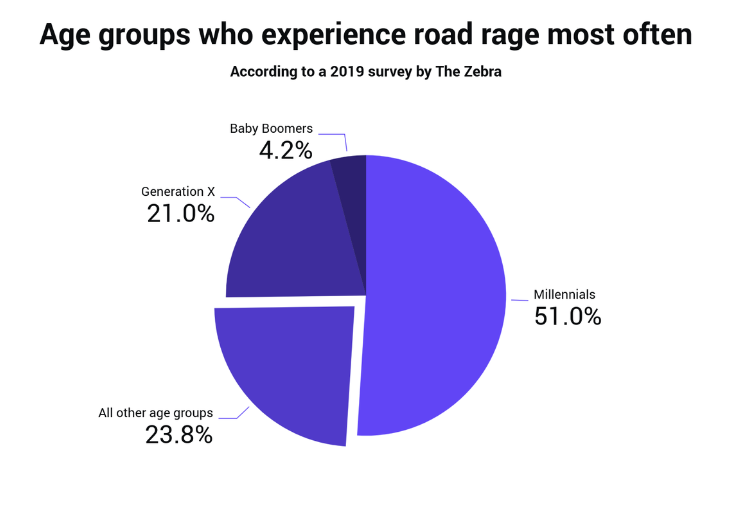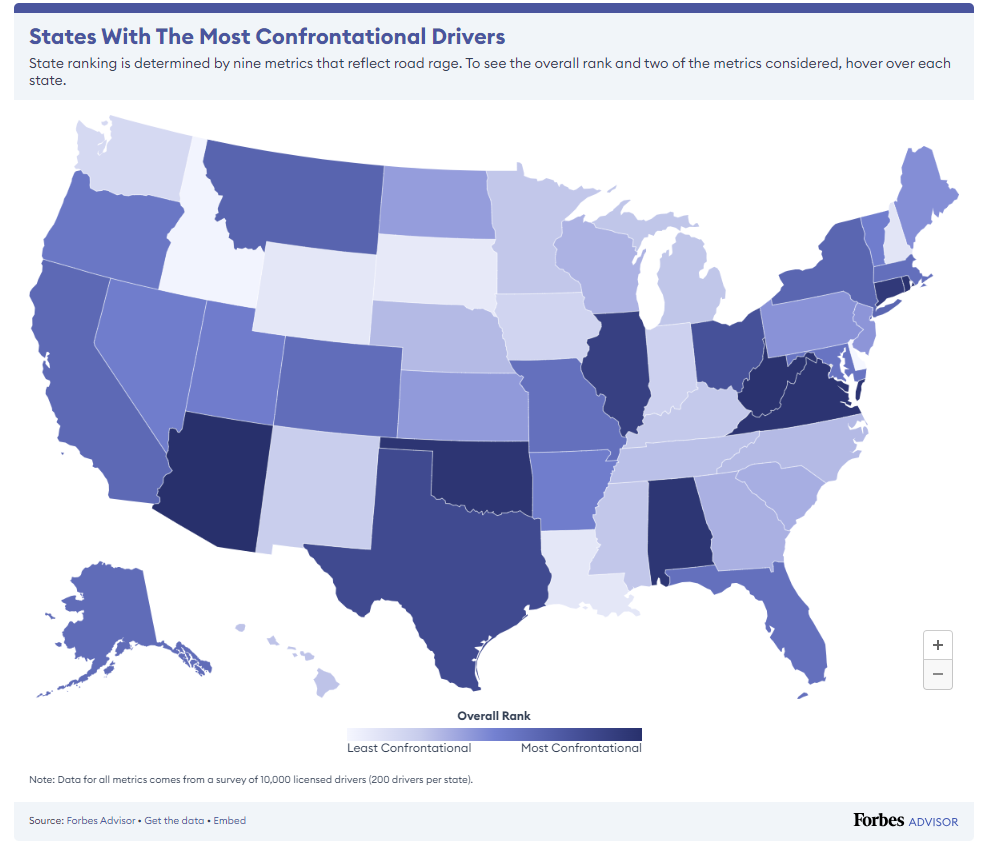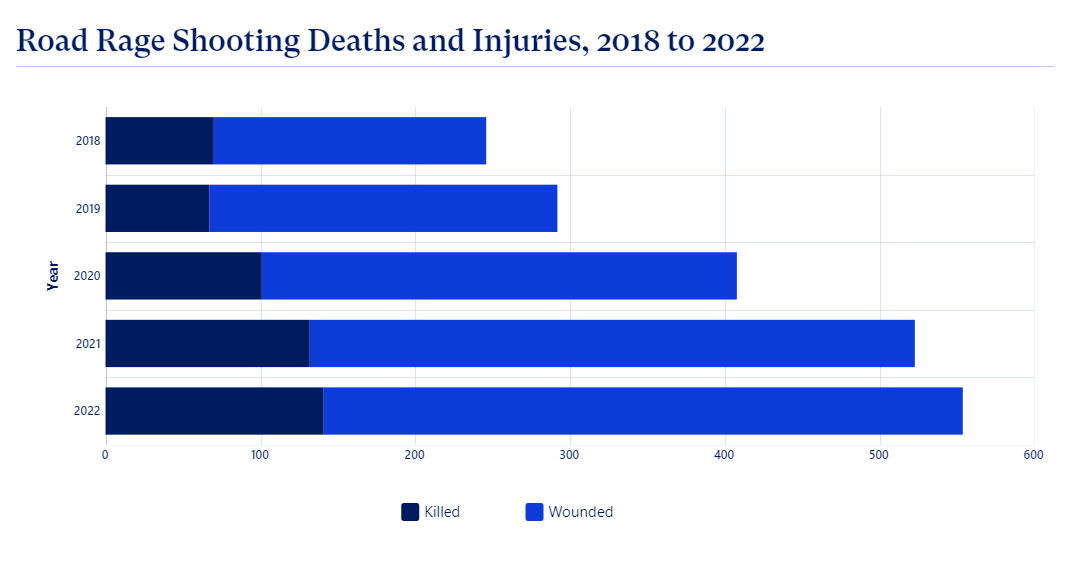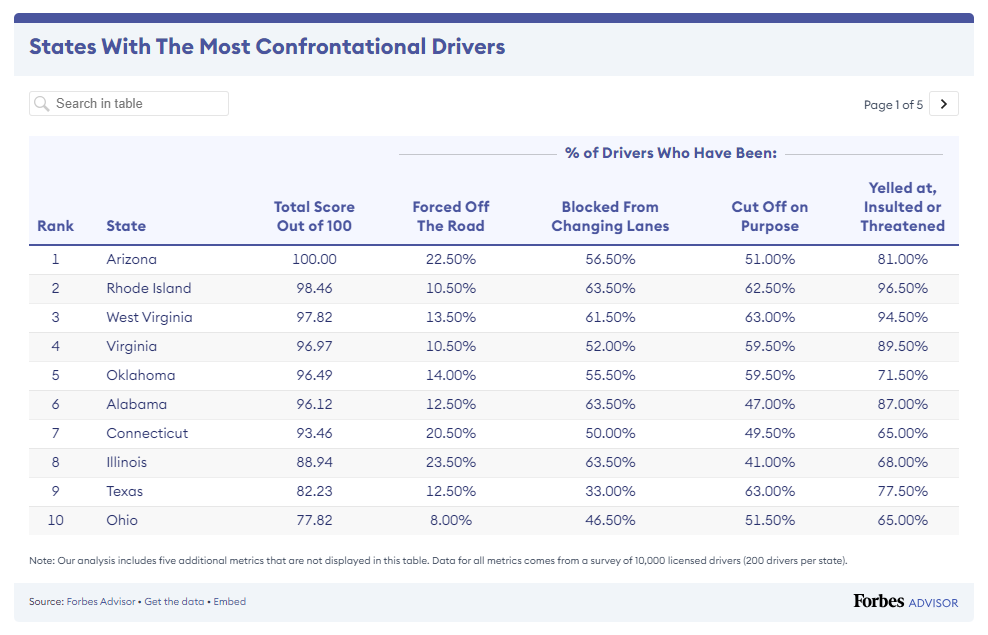Virginia drivers have some anger issues.
Forbes magazine interviewed 10,000 drivers across the U.S. Each of our 50 states received a score based on the answers, and Virginia came in at the fourth highest for aggression on our roadways.
Road rage and violent incidents are on the rise nationwide. The number of people injured in road rage shootings alone increased 135% from 2018 to 2022, Forbes reported.

Virginia road rage, by the numbers
- Over half of Virginia drivers say that they have experienced someone exiting their car to yell at them or start or a fight.
- About 90% of respondents say they’ve been cursed at, insulted, or threatened by another driver.
- Virginia ranks high for drivers that cut off other cars on purpose, honk excessively, and flip off other drivers.
- Nearly a quarter of Virginians report experiencing road rage “very frequently.”
This phenomenon happens most often on city streets, followed by highways.
How did the other states rate for road rage incidents?
The top five states with the most confrontational drivers were:
- Arizona (the most offenses)
- Rhode Island
- West Virginia
- Virginia
- Oklahoma

The states with the least confrontational drivers were:
- Idaho (the least offenses)
- New Hampshire
- South Dakota
- Louisiana
- Indiana
Top reported reasons for road rage
Texting or being distracted while driving seems to be a major factor in inciting rage. Seeing a distracted driver who mistakenly cuts you off or otherwise drives recklessly may lead to rage aimed at the irresponsible driver. Rather than engaging with them, it is safer and more effective to avoid them, or even better, pull over and call the authorities.
Among the drivers that Forbes surveyed, the top reasons cited for feeling road rage include:
- Heavy traffic (39.35%)
- Already feeling stressed (38.06%)
- Running late (33.89%)
- Already feeling angry (32.49%)
- Feeling tired (26.86%)
Where do drivers experience road rage the most?
Common locations where people experience confrontational driving include:
- City streets (29.18%)
- Freeways or highways (26.59%)
- Parking lots (14.9%)
- Intersections (12.36%)
- Rural roads (6.99%)
Road rage and guns
According to data collected, things can escalate quickly when someone loses their temper on the road. Per the Gun Violence Archive, road rage-related shootings doubled from 2018 to 2022. In 2018, the U.S. experienced 70 road rage-related shooting deaths, which doubled to 141 in 2022.

We see the same surge in numbers with gun-related injuries on the road. In 2018, there were at least 176 road rage-related injuries involving guns, but by 2022, it jumped to 413 people. The AutoVantage Club reports that 37% of road rage incidents involve a firearm.
Road rage and auto collisions
As anyone can assume, there is a high correlation between road rage and auto accidents. When a driver develops tunnel vision toward retaliation, whether to pass a vehicle or deliver a stern message, safety becomes secondary.
It should be noted that it’s very difficult to get an accurate number of how many accidents can be attributed to road rage. This factor is often underreported, whether to first responders, or underreported when police and other first responders submit their own reports.
According to the National Highway Traffic Safety Administration (NHTSA), aggressive driving is the culprit behind 66% of traffic fatalities. SafeMotorist estimates that at least 1,800 car accidents and injuries can be attributed to road rage incidents every year.
A driver’s chances of getting hurt on the road becomes much higher if they respond to the aggression. And according to the AutoVantage Club, about 50% of drivers do just that – they engage with the aggressive driver.
How confrontational driving affects auto insurance
Road rage can exact more than a mental toll. If an incident involves property damage, drivers should know that the national average car insurance rate will increase by 45%. The average rises to 47% if the incident includes bodily injury, per a Forbes advisor analysis. And this does not take into account any potential punitive or criminal damages associated with road rage.

Where you live in the U.S. makes a difference with the premium changes as well. The fluctuations by state can be staggering. California drivers see the biggest rate increases (97%) come renewal time, while Wyoming drivers can expect an average 31% increase.
If you’ve caused the accident, you will have better luck with insurance companies that are forgiving of driving records with recent incidents. Insurance carriers each assess risk differently, so comparing prices is vital to securing the best rates.
How to stay calm in stressful driving situations
If you find yourself frustrated behind the wheel, or being provoked by another driver, engaging with them isn’t worth the safety risk. Not to mention that road rage can carry criminal charges.
If you encounter an aggressive driver on the road, do not provoke them, communicate with them, or sustain eye contact. Drive at the speed limit with plenty of space around you. If you are being followed or tailgated, and feel afraid to park and exit your car at its destination, call 911. And if you are in close proximity to a police station, pulling into their headquarters is an easy way to get the aggressor to speed off.
Hackensack Meridian Health created a list of tips to help drivers reduce road rage. They are as follows:
- Do not take another driver’s actions personally. Assume that they’re having a bad day.
- Listen to music that you love – it can improve your mood.
- Breathe slowly and deeply to calm yourself down.
Here are some preventative measures to lower your chances of feeling aggressive while behind the wheel:
- Try to get 8 hours of sleep regularly. Drowsiness may make you feel more impatient, act more aggressively, or inspire you to take risks.
- Do not consume any alcoholic beverages before getting behind the wheel.
- Allow a few more minutes than you think you’ll need for each drive, so that you have built-in wiggle room. You will likely feel less stress and anger if you hit traffic.
If you or a loved one have been injured in a road rage incident through no fault of your own, you may be entitled to compensation. The experienced car accident attorneys at Allen & Allen are here to help. For a free case evaluation, call 866-388-1307 today.



